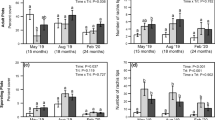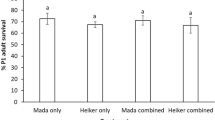Abstract
Effective biological control of a weed cannot be achieved unless agents can inflict sufficient damage for the plant’s growth and reproduction to be significantly depressed. The leaf-mining fly Hydrellia lagarosiphon is being considered for release in Ireland and New Zealand as a biocontrol agent for the invasive African macrophyte Lagarosiphon major. However no leaf-mining biological control agent has achieved successful control of any submerged macrophyte to date. Pre-release efficacy experiments help predict the likelihood of the biocontrol agents impact provided trials take into account expected agent densities and field conditions. Sustained damage induced by consecutive generations of the leaf-mining fly was capable of halting plant growth and undamaged shoot fragments produced 100 % more shoot biomass in just 70 days when compared with those exposed to larval damage. The number of larvae required to induce this level of damage was less than the maximum number of larvae a plant can sustain under both laboratory and natural field conditions and was between three and four larvae per shoot tip. Larval damage to L. major also had a significant effect on the subsequent establishment of detached apical shoots under field conditions. All control shoots displayed 100 % establishment whereas medium (three larvae per shoot) and high larval density plants (five larvae per shoot) had 85 and 25 % establishment, respectively. Pre-release trials indicate that relatively low larval abundances of H. lagarosiphon can contribute to the suppression of plant growth and reduce the establishment of shoot fragments, making this species a potentially effective biocontrol agent.



Similar content being viewed by others
References
Agrawal AA (2000) Overcompensation of plants in response to herbivory and the by-product benefits of mutualism. Trends Plant Sci 5:309–313
Baars J-R, Caffrey JM (2010) The Frond-feeding weevil (Stenopelmus rufinasus Gyllenhal) (Coleoptera: Erirhinidae) a natural enemy of Azolla filiculoides in Ireland. Ir Nat J 30:142–143
Baars J-R, Coetzee J, Martin G, Hill MP, Caffrey JM (2010) Natural enemies from South Africa improve the prospects for biological control of Lagarosiphon major (Ridl.) Moss ex Wager (Hydrocharitaceae) in Europe. Hydrobiologia 656:149–158
Balciunas JK, Burrows DW (1996) Distribution, abundance and field host-range of Hydrellia balciunasi bock (Diptera: Ephydridae) a biological control agent for the aquatic weed Hydrilla verticillata (L.f.) royle. Aust J Entomol 35:125–130
Balciunas JK, Center TD (1981) Preliminary host specificity tests of a Panamanian Parapoynx as a potential biological control agent for hydrilla. Environ Entomol 10:462–467
Begon M, Harper JL, Townsend CR (1996) Ecology: individuals, populations and communities, 3rd edn. Blackwell, Oxford
Buckley YM, Briese DT, Rees M (2003) Demography and management of the invasive plant species Hypericum perforatum. I. Using multi-level mixed-effects models for characterizing growth, survival and fecundity in a long-term data set. J Appl Ecol 40:481–493
Cabrera Walsh G, Magalí Dalto Y, Mattioli FM, Carruthers RI, Anderson LW (2012) Biology and ecology of Brazilian elodea (Egeria densa) and its specific herbivore, Hydrellia sp., in Argentina. Biol Control 57:1–15
Caffrey J, Millane M, Evers S, Moran H (2011) Management of Lagarosiphon major (Ridley) moss in Lough Corrib, a review. Biol Environ 111B:1–8
Center TD, Parys K, Grodowitz M, Wheeler GS, Dray FA, O’Brien CW, Cofrancesco A (2013) Evidence of establishment of Bagous hydrilla (Coleoptera: curculionidae), a biological control agent of Hydrilla verticillata (Hydrocharitales: Hydrocharitaceae) in North America? Fla Entomol 96:180–186
Clewley GD, Eschen R, Shaw RH, Wright DJ (2012) The effectiveness of classical biological control of invasive plants. J Appl Ecol 49:1287–1295
Coetzee JA, Bownes A, Martin GD (2011) Prospects for the biological control of submerged aquatic macrophytes. Afr Entomol 19:469–487
Cruttwell McFadyen RE (1998) Biological control of weeds. Annu Rev Entomol 43:369–393
Cuda JP, Coon BR, Dao YM, Center TD (2011) Effect of an herbivorous stem mining midge on the growth of hydrilla. J Aquat Plant Manag 49:83–88
Dempster JP, Pollard E (1981) Fluctuations in resource availability and insect populations. Oecologia 50:12–416
Doyle RD, Grodowitz MJ, Smart RM, Owens C (2002) Impact of herbivory by Hydrillia pakistanae (Diptera: ephydridae) on growth and photosynthetic potential of Hydrilla verticillata. Biol Control 24:221–229
Doyle R, Grodowitz MJ, Smart M, Owens C (2007) Separate and interactive effects of competition and herbivory on the growth, expansion, and tuber formation of Hydrilla verticillata. Biol Control 41:327–338
Earle W (2013) Field and laboratory based evaluation of natural enemies screened as biological control agents of the aquatic weed Lagarosiphon major. PhD thesis, University College Dublin, Ireland
Earle W, Mangan R, O Brien M, Baars JR (2013) Biology of Polypedilum n. sp. (Diptera: Chironomidae), a promising candidate agent for the biological control of the aquatic weed Lagarosiphon major (Hydrocharitaceae) in Ireland. Biocontrol Sci Tech 23:1267–1283
Fagan WF, Lewis MA, Neubert MG, van Den Driessche P (2002) Invasion theory and biological control. Ecol Lett 5:148–157
Grodowitz MJ, Cofrancesco AF, Stewart RM, Madsen J, Morgan D (2003) Possible impact of lake seminole Hydrilla by the introduced leaf-mining fly Hydrellia pakistanae. ERDC/EL TR-03-18, U.S. Army Engineer Research And Development Center, Vicksburg, USA
Grodowitz MJ, Owens CS, Smart RM, Nachtrieb HGM (2007) Impact of herbivory and plant competition on the growth of hydrilla in small ponds. APCRP-BC-08, U.S. Army Engineer Research And Development Center, Vicksburg, USA
Jongejans E, Sheppard AW, Shea K (2006) What controls the native population dynamics of the alien invasive thistle Carduus nutans in its native range? J Appl Ecol 43:877–886
Mangan R, Baars J-R (2013) Use of life table statistics and degree day values to predict the invasion success of Hydrellia lagarosiphon Deeming (Diptera: Ephydridae), a leaf mining fly of Lagarosiphon major (Ridley) Moss (Hydrocharitaceae), in Ireland and the rest of Europe. Biol Control 64:143–151
McFarland DG, Barko JW (1996) Investigations of the production, transport, and survival of monoecious Hydrilla propagules in the tidal Potomac River. Technical Report A-96-7, Aquatic Plant Control Research Program, Waterways Experiment Station, Vicksburg, MS
Owens CS, Grodowitz MJ, Smart RM (2008) Impact of insect herbivory on the establishment of Hydrilla verticillata (L.f.) Royle fragments. J Aquat Plant Manag 46:199–201
Paynter Q (2013) Feasibility of biocontrol of Lagaorsiphon major in New Zealand. Landcare Research Contract Report LC 1234 Landcare Research, Auckland, New Zealand
Peterson RKD, Higley LG (2001) Illuminating the black box: the relationship between injury and yield. In: Peterson RKD, Higley LG (eds) Biotic stress and yield loss. CRC Press, Boca Raton, pp 1–12
Rees M, Paynter Q (1997) Biological control of scotch broom: modelling the determinants of abundance and the potential impact of introduced insect herbivores. J Appl Ecol 34:1203–1221
Schooler S, Cabrera-Walsh W, Julien M (2009) Cabomba caroliniana gray (Cabombaceae). In: Muniappan R, Reddy GVP, Raman A (eds) Biological control of tropical weeds using arthropods. Cambridge University Press, Cambridge, pp 88–107
Smart RM, Barko JW (1984) Culture methodology for experimental investigations involving rooted submersed aquatic plants. Miscellaneous paper A-89_2, U.S. Army Engineer Waterways Experiment Station, Vickburg, USA
StatSoft, Inc., 2005. STATISTICA (data analysis software system), version 7.0 http://www.statsoft.co.za
Thomas PA, Room PM (1986) Taxonomy and control of Salvinia molesta. Nature 320:581–584
van Driesche R, Hoddle M, Center T (2008) Control of pests and weeds by natural enemies: an introduction to biological control. Blackwell, Malden
Wheeler GS, Center TD (2001) Impact of the biological control agent Hydrellia pakistanae (Diptera: Ephydridae) on the submersed aquatic weed Hydrilla verticillata (Hydrocharitaceae). Biol Control 21:168–181
Author information
Authors and Affiliations
Corresponding author
Additional information
Handling Editor: S. Raghu
Rights and permissions
About this article
Cite this article
Mangan, R., Baars, JR. Can leaf-mining flies generate damage with significant impact on the submerged weed Lagarosiphon major?. BioControl 61, 803–813 (2016). https://doi.org/10.1007/s10526-016-9759-7
Received:
Accepted:
Published:
Issue Date:
DOI: https://doi.org/10.1007/s10526-016-9759-7




